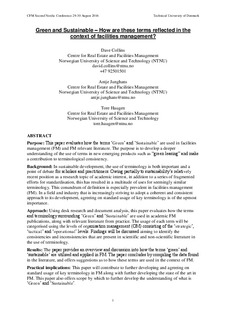Green and Sustainable – How are These Terms Reflected in the Context of Facilities Management?
Chapter
Submitted version
Permanent lenke
http://hdl.handle.net/11250/2404812Utgivelsesdato
2016Metadata
Vis full innførselSamlinger
Originalversjon
Jensen, Per Anker [Eds.] CFM Second Nordic Conference Proceedings 29-30 August 2016 p. 115-127, Polyteknisk Forlag, 2016Sammendrag
Purpose: This paper evaluates how the terms ‘Green’ and ‘Sustainable’ are used in facilities management (FM) and FM relevant literature. The purpose is to develop a deeper understanding of the use of terms in new emerging products such as “green leasing” and make a contribution to terminological consistency.
Background: In sustainable development, the use of terminology is both important and a point of debate for scholars and practitioners. Owing partially to sustainability’s relatively recent position as a research topic of academic interest, in addition to a series of fragmented efforts for standardisation, this has resulted in a multitude of uses for seemingly similar terminology. This conundrum of definition is especially prevalent in facilities management (FM). In a field and industry that is increasingly striving to adopt a coherent and consistent approach to its development, agreeing on standard usage of key terminology is of the upmost importance.
Approach: Using desk research and document analysis, this paper evaluates how the terms and terminology surrounding ‘Green’ and ‘Sustainable’ are used in academic FM publications, along with relevant literature from practice. The usage of each term will be categorised using the levels of organisation management (OM) consisting of the ‘strategic’, ‘tactical’ and ‘operational’ levels. Findings will be discussed aiming to identify the consistencies and inconsistencies that are present in scientific and non-scientific literature in the use of terminology.
Results: The paper provides an overview and discussion into how the terms ‘green’ and ‘sustainable’ are utilised and applied in FM. The paper concludes by compiling the data found in the literature, and offers suggestions as to how these terms are used in the context of FM.
Practical implications: This paper will contribute to further developing and agreeing on standard usage of key terminology in FM along with further developing the state of the art in FM. This paper also offers scope by which to further develop the understanding of what is ‘Green’ and ‘Sustainable’.
